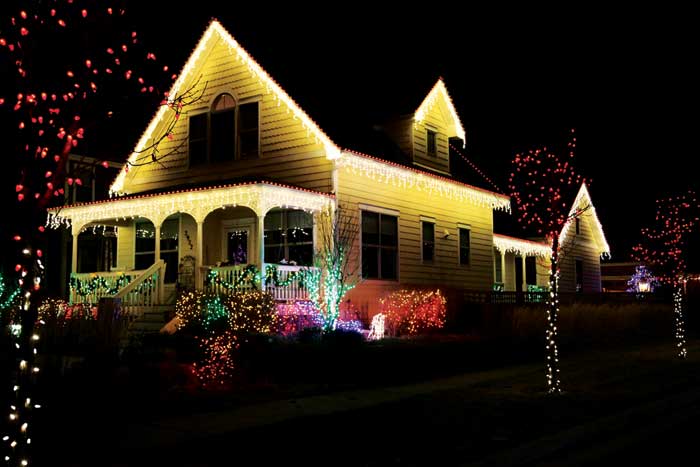
How do holiday lights impact our planet and our neighbors?
Shortly after I finished off the last of my kids’ “yucky” Halloween candy, holiday lights began popping up around the neighborhood. One by one appeared twinkling icicles, walkway candy canes, and bobbing reindeer. Soon they were joined by a jolly inflatable Santa and his best bud, Snoopy.
My inner elf yearned to put up our lights, too. Yet my environmental and frugal sides cautioned—aren’t we supposed to wait until Thanksgiving? Arrggh. Waiting is difficult, especially when every time I go to the store there’s another pre-Black Friday sale! Internally I schemed—should I go all-out this year and buy an inflatable dancing Santa in a hula skirt? Or max out the credit card with some spiffy new LED lights? Hey, aren’t LEDs supposed to be good for the environment? If so, maybe I can make our house look like the one in National Lampoon’s Christmas Vacation while saving the planet at the same time!
To figure this out, and sift through the sales pitches, I studied the lights in our ’hood, analyzed usage patterns, and did the math. The answer wasn’t what I expected.
Holiday decorators fall into four main categories: 1) Minimalists, who have a few strings of lights around their tree; 2) Conservatives, who brandish a mix of exterior and interior lights; 3) Martha Stewarts, whose light displays make Martha proud; and 4) Clark Griswolds, whose homes can be seen from 747s overhead.
Not surprisingly, the average celebrant of Hanukkah, the Jewish Festival of Lights, uses even less energy than the most minimalist Christmas participant. Ditto for Kwanzaa and non-Christmas celebrants. In Colorado, the average Minimalist’s holiday lighting habit only costs about $2/year in extra electricity, presuming they are using incandescent lights. Conservatives and Marthas who are using such lights tend to spend between $7 and $40 extra per year, and the average Griswold tops up their holiday electric bill by about $250. Were all of them to convert to LEDs, their annual holiday electricity increases would only be 10¢, $1, $10 and $40. Sounds like we all ought to run out to buy LEDs, right? Maybe not.
The ads say holiday LED lights pay for themselves. For interior mini-lights, it takes between six years (for Minimalists) and 30 years (for Marthas) for the amount of electricity cost savings to equal the amount you paid for them. In part this duration of LED “payback” is because: a) interior LED lights tend to cost three to four times as much as incandescents, not twice as much, as most energy models presume; b) most Colorado electricity is relatively cheap (4.6¢/kWh; also see http://www.eia.gov/electricity/monthly/epm_table_grapher.cfm?t=epmt_5_6_a); and c) because actual user habits for holiday decorations differ from estimated usages used in manufacturer/seller’s cost-benefit analyses.
But what about exterior lights, also known as C9s? For the Conservatives and Marthas out there, they can pay for themselves in one to five years. Even if you buy expensive ones and use them sparingly, they ought to pay for themselves in less than 14 years. So if your old holiday lights are worn or broken, exterior LEDs are a no-brainer. If you’re a first-time buyer, don’t even think old-school—you can shop your favorite big-box and find LEDs that cost the same as incandescents.
And those inflatables? My wife will be happy to know (at least, this is how I intend to argue for purchasing that kitschy hula Santa) that most use low-voltage blower motors and LEDs, yielding a total hourly energy consumption that is usually less than an outdoor floodlight.
How do these decorations impact our planet or our neighbors? Aesthetics aside, the biggest impact of holiday lights is on our air. Generation of extra electricity produces planet-warming CO2 gas, acid-rain-causing SO2 and lung-etching NOx gas. In Colorado, each Minimalist’s incandescent holiday lighting causes new production of gaseous pollutants equivalent to driving our minivan to Rocky Mountain National Park. Conservatives produce pollutants equivalent to a 225-mile ride in our swagger wagon, and Marthas create nearly as much pollution as a road trip to Vegas. Depending on your mix of lighting decorations, a LED switchover can make a 4- to 15-fold dent in your emissions. But unless you can see your house from space, or you have so many interior lights on that you don’t run your furnace in December, don’t lose sleep over it.
So what to replace, what to buy, and what to do? With some of the facts above, you can make your own calculations. The final decision may not lie with your inner economist or environmental conscience, but with the pleas of your loved ones.
James W. Hagadorn, PhD, is a scientist at the Denver Museum of Nature & Science. Suggestions and comments are welcome at jwhagadorn@dmns.org.



0 Comments